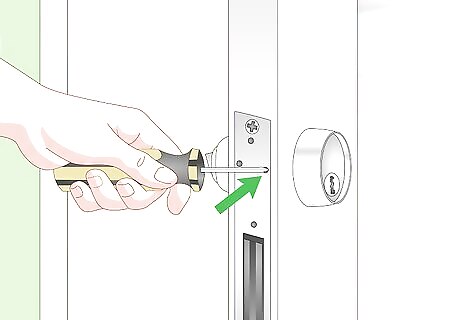
views
- To change an interchangeable lock cylinder, remove the flat screw, turn the key slightly to the right, remove the cylinder, and, turning the key back to the left, place the new cylinder.
- To replace a storefront cylinder, remove the faceplate and set screw, unscrew the lock, thread a new lock cylinder into the hole, and resituate the faceplate and set screw.
- For ignition lock cylinders, place a key in the ignition, put an Allen key in the nearby hole, turn the key clockwise, pull the ignition out, and insert the new lock cylinder.
Changing an Interchangeable Lock Cylinder

Remove the flat screw under the latch. Prop open the door as you change the lock. Turn the screw under the door latch counterclockwise with a flathead screwdriver and remove it. Put the screw somewhere safe because you'll have to screw it back in later.

Turn the key a quarter of the way. Insert the key into the keyhole and turn it slightly so that it's in the open position. This will hide the latch in the internal components of the lock and allow you to slide it out. If you don't turn the key then you won't be able to pull out the lock.

Pull on the key while pushing on the other side of the lock. Keep the key turned while you push on the lock from the other side of the door. If done correctly, the interchangeable lock cylinder should come out. If the cylinder feels stuck, try turning the key a little more or less. Adjust the key until you can push the latch out.

Turn the key and slide the new cylinder into the hole. Turn the key counterclockwise a quarter of the way open so that the latch goes inside of the lock cylinder. This will allow you to easily slide it back into the cylinder hole.

Screw the flat screw back in. Thread the screw into the hole with your fingers, then use a flathead screwdriver to tighten it. Continue turning it until it runs flush with the side of your door. Screwing in the flat screw will hold the lock cylinder in place.

Test your key to make sure that it unlocks your door. Keep the door open as you test it. If it doesn't work, try dissembling and reinstalling the lock cylinder or call a locksmith to see if they can replace it for you.
Replacing a Storefront Door Lock Cylinder

Unscrew and remove the faceplate over the latch. Use a doorstop to prop the door open while you’re working. Find the faceplate on the thin part of the door and use a Phillips head screwdriver to remove all the screws in it. Once the screws are out, pop the faceplate off the door. Place the screws in a sealable bag so that you don’t lose them.

Loosen the set screw near the lock itself. The set screw will be the screw closest to the lock cylinder on the outside of the door. Use a Phillips head screwdriver to turn the set screw counterclockwise until you loosen it. Loosening the set screw will allow you to rotate the lock cylinder. You don’t have to remove the set screw entirely, just loosen it enough so that you can turn the lock cylinder.

Insert a key into the lock and turn it clockwise to unscrew it. Use a different key than the one that unlocks the door so that you can use it as a wrench. Insert the mismatching key into the keyhole and turn it counterclockwise to loosen the cylinder. When the cylinder is loose enough, it should easily come out of the hole in the door. If you notice a lot of resistance, loosen the set screw more.

Thread a new lock cylinder into the hole. Put the new lock cylinder into the hole with the keyhole facing outward. Start threading the new cylinder by turning it clockwise in the hole. If there is a lot of resistance as you’re turning the key, it’s an indication that the threads aren’t catching correctly. In this case, unscrew the cylinder and start over from the beginning.

Insert a mismatching key into the lock and turn it clockwise. Again, use a key that isn’t made for the lock so that it catches and can be used as a wrench. Stop turning the cylinder when you feel resistance and the keyhole is on the bottom of the lock. As you turn the key, make sure that the threads on the cylinder are fitting in the threads around the hole for the lock.

Re-tighten the set screw. Turn the set screw clockwise to set the new lock cylinder in place. Once the set screw is tight, you should no longer be able to rotate the lock cylinder.

Screw the faceplate back on and test the lock. Fit the faceplate over the latch and line up the holes in the latch with the holes in the door. Use a screwdriver to secure the screws back in their holes. Use the correct key on the new lock to make sure that you installed it correctly and the door locks.
Changing an Ignition Lock Cylinder

Find the access hole to your ignition. Most models of cars will have an ignition access hole somewhere around the steering wheel. Check your user's manual to find it on your car. On Fords, there are usually 3 holes under your steering wheel. The smallest hole should be in the middle and is the access hole for your ignition. On Chevrolet brand cars, the access hole can usually be found on the top of the steering wheel. New cars that have electronic or push ignitions don’t have lock cylinders. If you don't have an ignition access hole, you'll need to remove the bottom of your steering wheel.

Put your key in the ignition. Your key needs to be in the ignition or you won’t be able to release the lock cylinder. Keep the key in the ignition as you continue working. Do not turn on the car. You don't have to turn the key initially.

Push an Allen key into the hole. As you push the Allen key into the hole, it should disengage the locking mechanism on the lock cylinder. You’ll have to keep the Allen key pressed into the hole as you move onto the next step. The Allen key disengages the locking mechanism in the lock cylinder.

Turn the ignition clockwise until it clicks. You should hear 2 clicks once the ignition disengages. Your car should not start. You can now release the Allen key from the hole. Keep the key in the ignition.

Pull the key ignition out. The ignition, or lock cylinder, should pop out after you turn it. Pull on the key to pull the lock cylinder completely out of its casing. If the ignition is sticking, wiggle it back and forth until you free it from its hole.

Insert the new lock cylinder and turn it counterclockwise until it clicks. Push your new lock cylinder into the hole and twist it towards you. The spring should engage, locking the new cylinder into place. Your new lock cylinder is now installed. You should hear it click when your ignition locks in place.



















Comments
0 comment